This article was originally posted on Geri Walton's own website on 1 November 2019, and appears here by kind permission. The illustrations all come from the original entry. Click on the images to enlarge them. Unless otherwise indicated in the caption, you may use them without prior permission for any scholarly or educational purpose as long as you (1) credit the source and (2) link your document to the original essay, or to this URL, or cite it in a print one. — Jacqueline Banerjee

Cremorne Gardens, No. 2, by James McNeill Whistler. [Click on image for more information.]
Cremorne Gardens were popular pleasure gardens by the side of the River Thames in Chelsea, London, located between Chelsea Harbor and the end of the King’s Road that flourished between 1845 and 1877. The gardens began after the property was sold in 1845 to Thomas Bartlett Simpson. He owned the North & South American Coffee House on Threadneedle Street and sublet the property to James Ellis, who had grown up in London and worked as a shopkeeper.
Ellis had made his money by selling confectionaries and further developed the site turning it into the Cremorne Gardens. His gardens offered a wide range of attractions that included a noisy colorful pleasure garden with concerts, dancing, fireworks, promenading, and restaurants. There were also balloon ascents with one of the first advertised in the Morning Advertiser on 15 September 1845 and stating:
Balloon by Moonlight! - Cremorne gardens, King’s road, Chelsea, To-morrow, Sept. 16, Mr. H. Green will make an ASCENT, at Ten o’clock at night in the Coronation Balloon, from a circle of purple light, and amidst blushes of scarlet fire. He will irradiate the multitude below by discharging from the car convulsive Roman candles, epileptic cat and wheels, and hysterical sky-rockets — Fete, fun and fire-works — Concert, ballet, and ball. Admission, 1s; Children half price. [1]
Ellis spent a fortune on the gardens and the same year that the famous wax sculptor Madame Tussaud died, was also the same year that Ellis went bankrupt. Simpson then took over management of the twelve-acre site and planned its new opening for 1846. In preparation 5,000 pounds were spent “and a banqueting-hall and theatre were constructed, as well as some ‘delightful lavender bowers’ for the accommodation of the 1,500 persons who were likely to need a bowery seclusion” (Wroth 6).
The grand entrance to the gardens was located on King’s Road and highlighted by a huge star that illuminated the “pay-box,” along with well-lit grounds. One early twentieth century guidebook about London gardens provided a further description of the site: "The most conspicuous feature was the orchestra to the south-west portion of the gardens — a ‘monster pagoda’ brilliantly lighted with hundreds of coloured lamps, and surrounded by a circular platform, prepared, it is said, to accommodate 4,000 dancers” (Wroth 6-7).
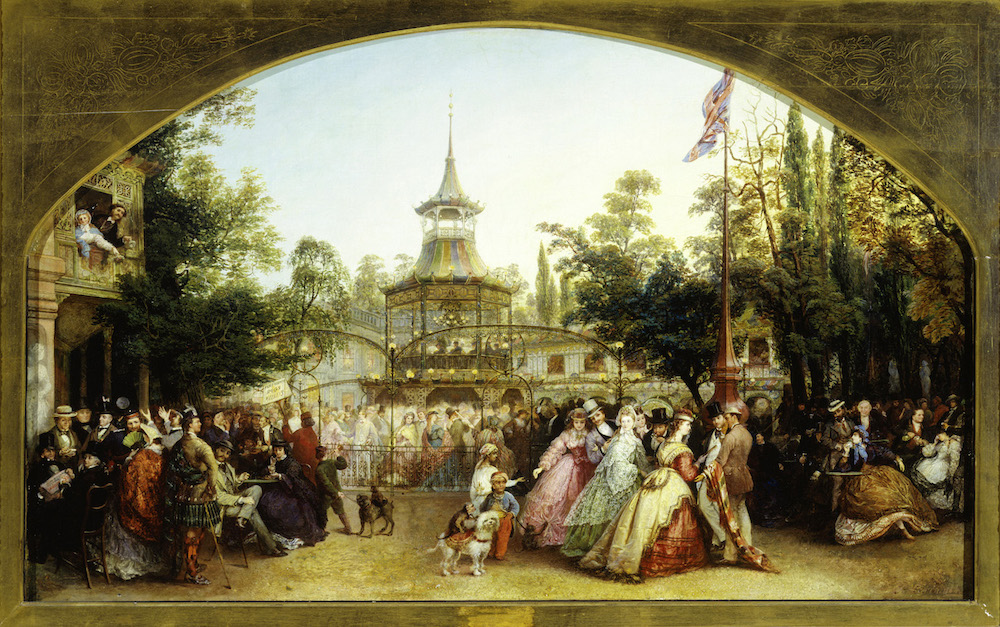
Phoebus Levin's The Dancing Platform at Cremorne Gardens, 1864. Collection: Museum of London (via Wikipedia, where it is identified as being in the public domain).
In Phoebus Levin's painting, shown above, a crowd has gathered on a typical summer’s evening in the southwestern corner of Cremorne Gardens, with visitors ranging from respectable families to the less acceptable prostitutes. In the distance is a pagoda with an orchestra playing and people dancing, as well as a double tier of supper boxes for diners.
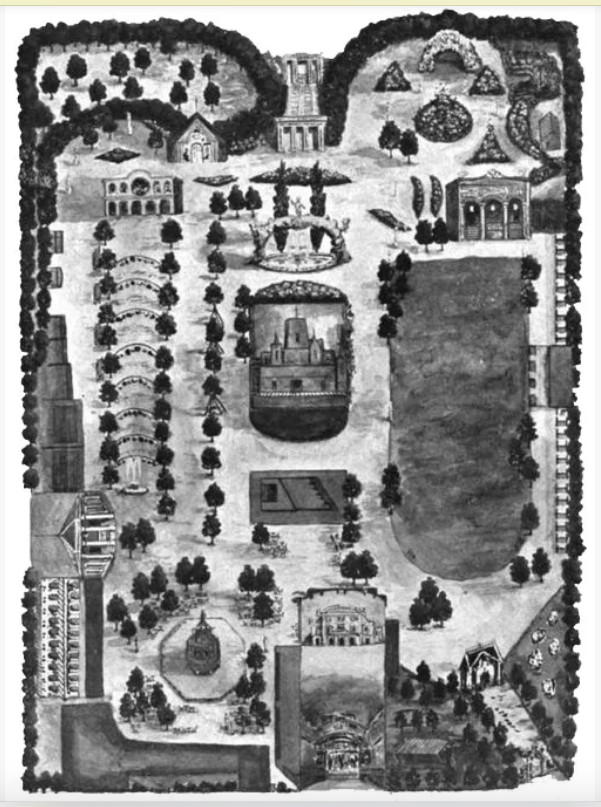
Cremorne Gardens layout in the 1870s. Source: Wroth 6. [Public domain.]
The gardens were also well-laid out and offered ample amenities, such as the following:
There were side shows, shooting galleries, a fringe of ancient trees and an avenue of the west that stretched north to south. There were also fountains and statuary; refreshment-bars, boxes, and tables … placed at every coign of vantage, though the right place to go was the Cremorne House (or Hotel) dining-room, or the upper and lower tiers of supper-boxes in the south and south-western corner. … In the centre of the grounds was an American bowling-saloon, which made its appearance, together with Americans drinks, in ‘48 or ‘49. … … On the west side was the circus; the theatre was in the south of the garden. A smaller theatre, north of the law was appropriate to a troupe of marionettes … Besides this there was a maze and (as Vauxhall had its hermit) a gipsy’s tent and a "double-sighted youth.” [Wroth 7-8]
The gardens became highly popular under Simpson’s management during London’s summer season. There were several contributing factors that resulted in its success, such as reasonably priced admittance at a shilling and season tickets costing one to two guineas. Access was also easy. Patrons could reach the grand entrance from Charing Cross by hackney or omnibus and during the summer evenings it was possible to arrive by a three-penny steamer that allowed visitors to disembark by the river gate on the south-east corner of the gardens.
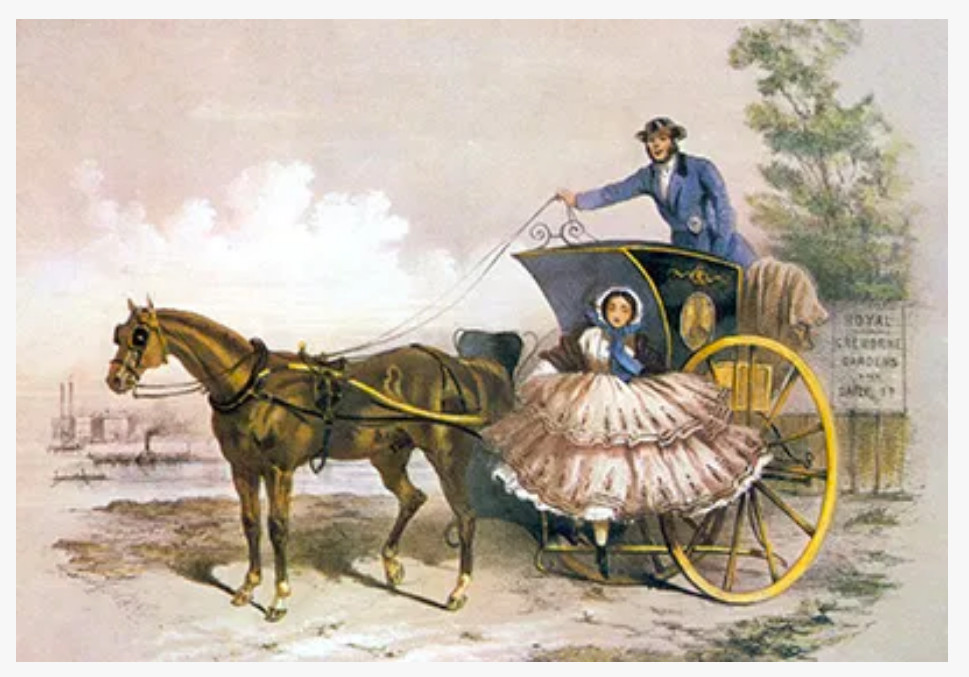
A couple arriving at the Cremorne Gardens. Author’s collection. [May require permission to reproduce.]
Newspaper advertisements about no charge for promenading in the Cremorne Gardens began to run in June of 1846, although each visitor was expected to buy a “Refreshment Card” amounting to sixpence. The gardens were opened every Sunday afternoon at half-past four and cited as the “most eligible place” for club dinners and celebrations of benefit societies. In addition, the gardens were also available for “Gala Night” on Monday, Wednesday, and Friday with an adult admission priced one shilling and children paying half-pence. On the off days of Tuesday and Thursday admission was a mere sixpence.
Around the same time that Cremone Gardens opened in 1846 a grand public breakfast, morning concert, and fete was hosted there. The Sun's advertisement for this "Grand Public Breakfast” on 15 July 1846 stated:
THIS DAY, July 15th, entitled "Ranelagh Revived; or, One Hundred Years Ago."" No pen can describe the gorgeous splendour with which this entertainment is being got up. We are all musical now; everybody should be there. The musical arrangements under the conduct of Mons. Laurent, Jun.; leader, Mr. Shargool; chorus-master, M. Salabert. The orchestra and chorus will consist of more than a hundred artistes, including the following distinguished solo performers — Messrs. Carte, Grattan Cooke, Winterbottom, Tyler, Jennings, Catchpole, Edgar, Pigot, Jolley, Wuestermann, &c. Doors open at three o’clock. The public breakfast will be laid from four to seven o’clock. Admission, 2s. 6d. Children, 1s. Half-price at half-past seven o’clock, 1s. Double Tickets, 4s. Tickets to admit three, 5s. 6d. Ticket to admit six, 10s. Breakfast ticket, 3s. These tickets and prospectuses may be obtained of any respectable Librarian, Music seller, and Confectioner in the metropolis.[1]
A couple of weeks later “eccentric entertainments” were offered at Cremorne Gardens and again publicized in London’s Sun. The advertisement read:
Souper et Bal Costume, or a Ranelagh Supper in Costume of the period and Grand Ball. This day, Wednesday, July 29. Doors open at Five; Performances commence at Half-past Six o’clock. Supper laid in the extensive galleries of the Ball-room at Nine o’clock. Admission, 2s. 6d. Supper, 5s. Tickets of admission (including Supper), 6s. to be had of all Court Costumiers. Mr. Simmonds, of 7, Tavistock-street, Strand, is appointed Costumier to the Gardens, and will provide dresses, at moderate charges, in the mansion. No person in masque, or dressed as clown, harlequin, Pantaloon, or columbine, will, on any account, be admitted. Remember, the costume of ladies and Gentlemen of the period of Ranelagh. [“Another Eccentric Entertainment,” 29 July 1846: 1]
George Augustus Sala, an author and journalist who wrote extensively for the Illustrated London News, compared Cremorne Gardens to Vauxhall in 1850 stating: “Cremorne was a real pleasaunce surrounded by magnificent trees, with well-kept lawns and lovely flowers, and melodious singing birds. Nothing was pleasanter in the summer-time than to saunter in at midday or in the early afternoon (for the gardens were not properly open till three or five), and find Mr. Simpson’s daughters there with their work-baskets" (qtd. in Wroth 6).
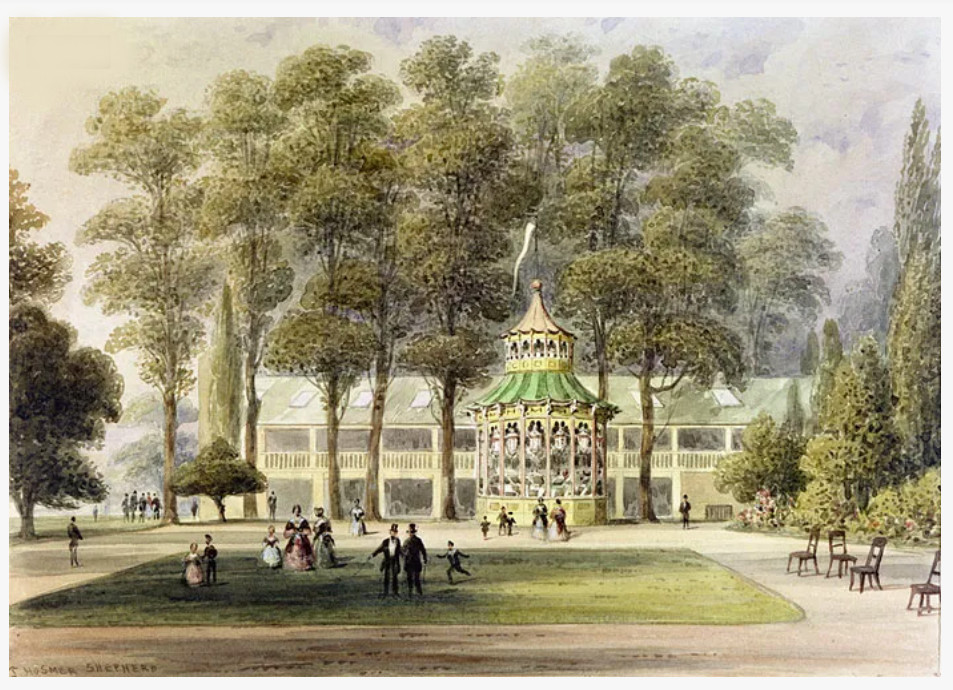
T. H. Shepherd's depiction of the Cremorne Gardens in 1852, showing the bandstand. Courtesy of the Royal Borough of Kensington and Chelsea. [May require permission to reproduce.]
Despite all the wonderful things said about Cremorne Gardens, there were also times when there were problems. That was the case in 1860 when Simpson found himself facing various “meteorological” challenges and engaged in a “perpetual struggle” against the weather. In fact, it was reported in the Sun of 6 October that year, “during the whole season of 1860 there have been only 50 nights on which the visitor could remain in the open gardens till anything like a late hour.” To aid patrons, Simpson expended his efforts in providing alternative amusements that did not rely on good weather:
Stereorama, that masterpiece of Messrs. Grieve and Telbin, combining the peculiarities of the theatrical set scene with those of the panorama, was a novelty that could be witnessed amid the storms of 1860 as comfortably as Mr. Burford’s pictures in Leicester-square; and the same may be said of the fine collections of ferns, which is reported to have cost several thousand pounds, and was another new feature of the season. An elegant dining room added to the hotel may also be mentioned among the fresh indoor amusements. [“Cremorne Gardens,” 1]
Unfortunately, despite providing some new amusements, there were complaints from residents about the importance of the Cremorne Gardens. Critics had been grumbling for some years and complaints were renewed by certain “Chelsea folk” who alleged that Cremorne’s attractions appealed more to metropolitan visitors than people from Chelsea or Chamberwell. There were also objections about the traffic and criticism that visitors to the gardens created a nuisance. The Sun also reported that critics were “opposed on the ground of local annoyance, and the encroachments made upon the rest of Chelsea slumberers by the noise of the choice spirits who return late from Cremorne” (“Cremorne Gardens,” 6 October 1860: 1]
Simpson retired in 1861 and Edward Tyrrell Smith then took over. He began by offering a “startling novelty” a female Blondin who undertook to cross the Thames River on a high wire. Thousands of spectators lined upon along the riverbanks and the esplanade of Cremorne to watch the female Blondin, who called herself Madame Genvieve but was really Selina Young. The rope she was to traverse was 600 or 700 feet long and ranged from 50 to 100 feet in height. She got about two-thirds the way across when the rope began to sway, she suddenly let go, caught the rope with both hands, and descended by another rope safely into a boat.
That wasn’t the only high-wire act at the appeared at Cremorne Gardens. Carlo Valeiro, a wire walker and gymnast, had been successful performing at the gardens for about two months when he was involved in a fatal accident in 1863. The cable he was using was about 600 feet in length and about 60 feet off the ground. A friend of a London correspondent for the Liverpool Albion witnessed the accident and reported: “On Thursday evening … the wire slackened the unfortunate man staggered. and was precipitated violently to the ground on the back of his head, the blood pouring profusely from the wound and from his ears. Numbers of persons, particularly the females, were dreadfully shocked and affected, many of the corps de ballet being afterwards scarcely able to go through their performance. He was immediately removed, and the dance and music proceeded” (“The Fatal Accident at Cremorne Gardens,” 5).
When the accident happened, it created more controversy for Cremorne Gardens. Critics were incensed that such a dangerous act was allowed, and they stated:
We are quite sure that we only give expression to the general feeling on the subject in saying that the time has arrived when managers should unanimously refuse to give permission to these dangerous exhibitions. The numerous accidents that have arisen from the acrobats testing their nerve and skill to the utmost, the effort that each new candidate for public fame makes to excel in desperate feats of hardihood [from that of] his predecessor, the unseen influences that may affect the security of the rope, and the peril in which the exhibitor not only places himself, but the limbs and lives of the spectators, should be all remembered when these engagements are proposed. The only safeguard that we see against a recurrence of these fearful misadventures is in the stern resolve of the proprietors of all places of amusement that they will not countenance any offer of the kind, and we believe their interests will not suffer when it is understood on what ground their objections are based. [“The Fatal Accident at Cremorne Gardens,” 5]

Cremorne Gardens Maypole. Author’s collection. [May require permission to reproduce.]
Although there might have been controversy about Cremorne Gardens, there were some things done right that encouraged people to visit. One marketing scheme that was brilliant, just like Madame Tussaud’s marketing scheme of promenading to music, happened sometime in the 1860s. It involved a “charming” folding program that was printed in color and presented nice views of Cremorne on every page. In addition: “Portions of the programme were ingeniously cut out, so that on the front page there was a view up the long walk, flanked by its trees and lamp-bearing goddesses, right to the great fountain. Another page depicted the supper-table spread with its choice viands and ‘rarest vintages,’ and on another was a view of the circus, the supper-boxes, and the promenade enlivened by a peripatetic band” (Wroth 11-12).
Several successful Cremorne events were also held. One was a tournament in 1863 that was based on the type of tournaments one might witness during medieval times: "The tournament King, the Queen of Beauty, and their suite, were escorted to a tapestried tribune … The heralds made the proclamation, and the jousting began. First there were trials of skill between knights … mounted on chargers with emblazoned housings. Some sports, like tilting at the ring and quintain, followed, and then came the grand melee between the two companies of knights. Finally, one of the combatants was unhorsed … and his antagonist received the prize of valour from the Queen of Beauty. Bands of music and facetious clowns, or rather ‘jesters’ enlivened the proceedings” (Wroth 11-12).
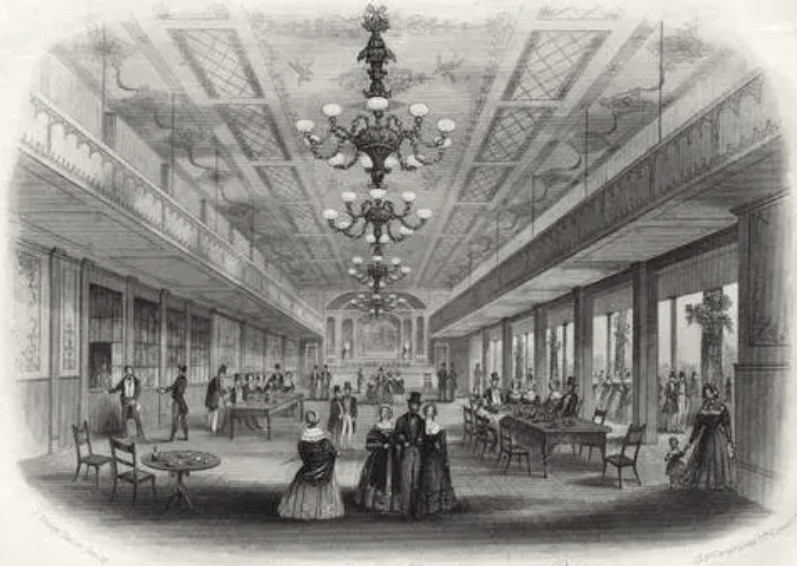
Interior of the banqueting hall, Cremorne Gardens. Source: The Miriam and Ira D. Wallach Division of Art, Prints and Photographs: Picture Collection, New York Public Library Digital Collections. [Public domain.]
Unfortunately, dangerous acts, inventive programs, and medieval jousting were not enough to help sustain Cremorne Gardens. From the beginning of its founding it seemed to maintain a less desirable reputation than some of the other available venues. In addition, it did not matter what inventive ideas were presented at the gardens:
[It was] never able to parade in the newspapers that array of fashionable and distinguished personage who … visited Vauxhall. It was not, for one thing, a place that ladies (in the strict sense of the word) were in the habit of visiting, unless, perhaps (as Mr. Sala puts it) "in disguise and on the sly."" … Ladies of some sort were, no doubt, considerably in evidence there, though we are not to think of Cremorne as so entirely given over to ‘drink, dancing, and devilry,’ as its sterner critics declared. If it was a place for the man about town, it also attracted a number of worthy citizens and country cousins who went there for an evening’s pleasure with their wives and daughters, and were "not particular” (Wroth 11).
Over the years, this less than stellar clientele worked against Cremorne Gardens until by the late 1860s it seemed that “as Cremorne grew older, the rowdy and wanton element … increased” (Wroth 11). Throughout the 1870s there were reports of frequent “rows.” It was further claimed that in the 1870s it was practically impossible to visit the gardens without some sort of police action happening as they were either maintaining order or removing prostitutes. “Even the normal evenings at Cremorne were fairly fertile in incident … the bars and boxes were so many hives of drinking mortals” (Wroth 20).
With all the undesirable elements frequenting Cremorne Gardens numerous critics began filing annual petitions against the garden renewing its license. Reasons given included its late hours, the immoral character of female frequenters, and its harmful influence on people’s morals. However, what may have been more important was that local homeowners began to complain that their property values were reduced because of the gardens.
Although critics and homeowners complained about Cremorne Gardens that is not why it ultimately closed in 1877. A man named John Baum began to lease the gardens in 1870. He eventually filed a libel case in May of 1877 against a minister named Alfred Brandon, who claimed the gardens were “the nursery of every kind of vice" (Wroth 21). Baum won his libel case but was only awarded a farthing in damages by the jury. At the time of the suit Baum was in debt and after the verdict he became ill and was unable to supervise Cremorne personally for several months. Around the end of September, he filed to renew the garden’s license but then shockingly withdrew his application without explanation. With that Cremorne Gardens closed for good on 5 October 1877 (see Timbs 22).
Related Material
- Whistler's Cremorne Gardens, No. 2
- Walter Greaves's Cremorne Gardens at Night
- Walter Greaves's The Band Stand, Cremorne Gardens
- Walter Greaves's The Gates to Cremorne Gardens
- Cremone Gardens — The Orchestra (1851 Illustrated London News)
Bibliography
"Another Eccentric Entertainment." Sun. 29 July 1846: 1.
"Cremorne Gardens.” Sun. 6 October 1860: 1.
“The Fatal Accident at Cremorne Gardens.” Dundee, Perth, and Cupar Advertiser. 30 June 1863: 5.
“Grand Public Breakfast.” Sun. 15 July 1846: 1.
Morning Advertiser. 15 September 1845: 1.
Timbs, J. Club Life of London with Anecdotes of the Clubs, Coffee-Houses and Taverns of the Metropolis During the 17th, 18th, and 19th Centuries. Vol. 2 London: Richard Bentley, 1866. Available on Project Gutenberg.
Wroth, W. W. Cremorne and the Later London Gardens. London: E. Stock, 1907. Available on Project Gutenberg.
Created 20 November 2020